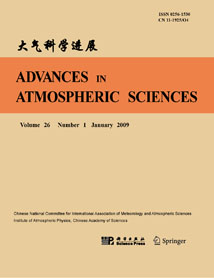| [1] |
GUO Xiaofeng, ZHANG Hongsheng, CAI Xuhui, KANG Ling, LI Wanbiao, DU Jinlin,
2007: Discrepancy and Applicability of Various Similarity Functions in Flux Calculations Under Stable Conditions, ADVANCES IN ATMOSPHERIC SCIENCES, 24, 644-654.
doi: 10.1007/s00376-007-0644-2
|
| [2] |
ZHONG Zhong, ZHAO Ming, SU Bingkai, TANG Jianping,
2003: On the Determination and Characteristics of Effective Roughness Length for Heterogeneous Terrain, ADVANCES IN ATMOSPHERIC SCIENCES, 20, 71-76.
doi: 10.1007/BF03342051
|
| [3] |
LI Weiping, LUO Yong, XIA Kun, LIU Xin,
2008: Simulation of Snow Processes Beneath a Boreal Scots Pine Canopy, ADVANCES IN ATMOSPHERIC SCIENCES, 25, 348-360.
doi: 10.1007/s00376-008-0348-2
|
| [4] |
LI Maoshan, MA Yaoming, MA Weiqiang, HU Zeyong, ISHIKAWA Hirohiko, Zhongbo SU, SUN Fanglin,
2006: Analysis of Turbulence Characteristics over the Northern Tibetan Plateau Area, ADVANCES IN ATMOSPHERIC SCIENCES, 23, 579-585.
doi: 10.1007/s00376-006-0579-z
|
| [5] |
ZHUO Jinqing, HUANG Jianping, WANG Jiemin, ZHANG Wu, BI Jianrong, WANG Guoyin, LI Weijing, FU Peijian,
2009: Surface Turbulent Flux Measurements over the Loess Plateau for a Semi-Arid Climate Change Study, ADVANCES IN ATMOSPHERIC SCIENCES, 26, 679-691.
doi: 10.1007/s00376-009-8188-2
|
| [6] |
GAO Zhiqiu, BIAN Lingen, CHEN Zhigang, Michael SPARROW, ZHANG Jiahua,
2006: Turbulent Variance Characteristics of Temperature and Humidity over a Non-uniform Land Surface for an Agricultural Ecosystem in China, ADVANCES IN ATMOSPHERIC SCIENCES, 23, 365-374.
doi: 10.1007/s00376-006-0365-y
|
| [7] |
Jianguo Niu, Hiroaki Kuze, Nobuo Takeuchi,
2000: Studying Air Pollution with Kitt Peak Solar Flux Atlas-Analysis Method and Results of Observation, ADVANCES IN ATMOSPHERIC SCIENCES, 17, 363-374.
doi: 10.1007/s00376-000-0029-2
|
| [8] |
Lei LIU, Guihua WANG, Ze ZHANG, Huizan WANG,
2022: Effects of Drag Coefficients on Surface Heat Flux during Typhoon Kalmaegi (2014), ADVANCES IN ATMOSPHERIC SCIENCES, 39, 1501-1518.
doi: 10.1007/s00376-022-1285-1
|
| [9] |
Zeng Xinmin, Zhao Ming, Su Bingkai,
2000: A Numerical Study on Effects of Land-Surface Heterogeneity from “Combined Approach” on Atmospheric Process Part I: Principle and Method, ADVANCES IN ATMOSPHERIC SCIENCES, 17, 103-120.
doi: 10.1007/s00376-000-0047-0
|
| [10] |
Runhua YANG, Jing GUO, Lars Peter RIISH?JGAARD,
2006: Application of an Error Statistics Estimation Method to the PSAS Forecast Error Covariance Model, ADVANCES IN ATMOSPHERIC SCIENCES, 23, 33-44.
doi: 10.1007/s00376-006-0004-7
|
| [11] |
Chengyan LIU, Zhaomin WANG, Bingrui LI, Chen CHENG, Ruibin XIA,
2017: On the Response of Subduction in the South Pacific to an Intensification of Westerlies and Heat Flux in an Eddy Permitting Ocean Model, ADVANCES IN ATMOSPHERIC SCIENCES, 34, 521-531.
doi: 10.1007/s00376-016-6021-2
|
| [12] |
Shenming FU, Jie CAO, Xingwen JIANG, Jianhua SUN,
2017: On the Variation of Divergent Flow: An Eddy-flux Form Equation Based on the Quasi-geostrophic Balance and Its Application, ADVANCES IN ATMOSPHERIC SCIENCES, 34, 599-612.
doi: 10.1007/s00376-016-6212-x
|
| [13] |
ZOU Han, LI Peng, MA Shupo, ZHOU Libo, ZHU Jinhuan,
2012: The Local Atmosphere and the Turbulent Heat Transfer in the Eastern Himalayas, ADVANCES IN ATMOSPHERIC SCIENCES, 29, 435-440.
doi: 10.1007/s00376-011-0233-2
|
| [14] |
Feng ZHANG, Yadong LEI, Jia-Ren YAN, Jian-Qi ZHAO, Jiangnan LI, Qiudan DAI,
2017: A New Parameterization of Canopy Radiative Transfer for Land Surface Radiation Models, ADVANCES IN ATMOSPHERIC SCIENCES, 34, 613-622.
doi: 10.1007/s00376-016-6139-2
|
| [15] |
LIU Li, WANG Tijian, SUN Zhenhai, WANG Qingeng, ZHUANG Bingliang, HAN Yong, LI Shu,
2012: Eddy Covariance Tilt Corrections over a Coastal Mountain Area in South-east China: Significance for Near-Surface Turbulence Characteristics, ADVANCES IN ATMOSPHERIC SCIENCES, 29, 1264-1278.
doi: 10.1007/s00376-012-1052-9
|
| [16] |
Jie MING, Jun A. ZHANG,
2016: Effects of Surface Flux Parameterization on the Numerically Simulated Intensity and Structure of Typhoon Morakot (2009), ADVANCES IN ATMOSPHERIC SCIENCES, 33, 58-72.
doi: 10.1007/s00376-015-4202-z
|
| [17] |
Li Wei, Yu Rucong, Liu Hailong, Yu Yongqiang,
2001: Impacts of Diurnal Cycle of SST on the Intraseasonal Variation of Surface Heat Flux over the Western PacificWarm Pool, ADVANCES IN ATMOSPHERIC SCIENCES, 18, 793-806.
|
| [18] |
Fuqiang YANG, Li DAN, Jing PENG, Xiujing YANG, Yueyue LI, Dongdong GAO,
2019: Subdaily to Seasonal Change of Surface Energy and Water Flux of the Haihe River Basin in China: Noah and Noah-MP Assessment, ADVANCES IN ATMOSPHERIC SCIENCES, 36, 79-92.
doi: 10.1007/s00376-018-8035-4
|
| [19] |
TANG Yanbing,
2004: Connections between Surface Sensible Heat Net Flux and Regional Summer Precipitation over China, ADVANCES IN ATMOSPHERIC SCIENCES, 21, 897-908.
doi: 10.1007/BF02915592
|
| [20] |
ZHOU Lian-Tong, HUANG Ronghui,
2010: An Assessment of the Quality of Surface Sensible Heat Flux Derived from Reanalysis Data through Comparison with Station Observations in Northwest China, ADVANCES IN ATMOSPHERIC SCIENCES, 27, 500-512.
doi: 10.1007/s00376-009-9081-8
|















 AAS Website
AAS Website 
 AAS WeChat
AAS WeChat 
 DownLoad:
DownLoad: